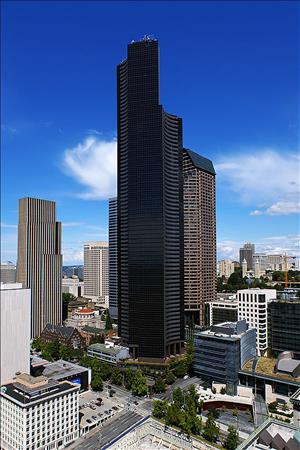On May 16, 1989, Initiative 31, the Citizens' Alternative Plan (CAP), which sets growth limits on downtown Seattle, wins at the polls. The initiative establishes density and height limits on new construction and "design review" to permit the City to modify project plans. Although voter turnout is only 23 percent, the 2-1 majority vote serves as a message to City Hall to improve its management of development. Seattle becomes the second city on the West Coast to enact such a measure, behind San Francisco in 1986. The limits will be effectively repealed with new downtown zoning in 2006.
The CAP placed a height limit of 85 feet on new buildings. A department store could be 150 feet if it contained a theater. Office buildings were limited to 450 feet. No more than 500,000 square feet of space could be added in a year until 1994. From 1994 to 1999, the limit was one million square feet. The city council could not change the limits for two years.
Too Much of a Good Thing?
The Citizens Alternative Plan was written as a reaction to the new Downtown Seattle Land Use Plan, approved in 1984 but suspended until 1986, which permitted significantly larger structures in exchange for various design features and public amenities. Public concern was intensified by the extent of downtown construction in the late 1980s. Major projects included the Metro Transit Tunnel and new office towers such as Two Union Square, City Centre, and the Washington Mutual Tower (the first building completed under the 1984 plan). Some joked that Seattle had become a "sister city" of Beirut, then a bombed-out ruin.
Many urban-design critics regarded the new zoning as too generous, although most recent office construction predated it and was chiefly fueled by generous federal tax credits repealed in 1986. CAP authors included architect-activist Peter Steinbrueck (elected to the City Council in 1997), former Allied Arts president Margaret Pageler (a member of the City Council from 1993 to 2002), deputy City Attorney Ted Inkley, and City Council member Jim Street (Council member from 1984 to 1996). The pro-CAP campaign was also fueled by frustration over the failure to preserve Westlake Park as open space under a plan, ironically, endorsed by Victor Steinbrueck (Peter's father) shortly before his death in 1984.
Class Warfare at the Polls
Most developers (but not, notably, Martin Selig, who had built the city's tallest building) and downtown retailers opposed the initiative. Opponents formed Citizens for a Better Downtown (CBD) and organized beyond the Downtown Seattle Association by obtaining the support of labor unions, minority community groups, many architects, and almost all of Seattle's elected officials, who opposed the CAP measure as a threat to downtown economic health and employment and as a potential spur for suburban sprawl. The CBD campaign was led by Jon Bridge and Dorothy Bullitt, and staffed by Gogerty Stark consultants.
The city council failed to head off the initiative by passing growth limits of its own, and set the special election for May 1989, the first single-issue election, except for school levies, since May 1970. In one of the city's more divisive elections, the pro-CAP campaign vilified its critics as tools and dupes of downtown developers. Meanwhile, the anti-CAP campaign ran into trouble with its hard-hitting ads and assertions that passage would result in higher taxes and traffic gridlock. Mayor Charles Royer, a CAP opponent, stated, "The campaigns in both cases were irresponsible. There was overreaction. There was excessive rhetoric. It is not the way to do land-use planning."
From Top to Bottom
University of Washington public affairs professor Hubert Locke said, "There is a strong feeling that the growth people overplayed their hand." On the other hand, economist Glenn Pascall defended leftwing CAP opponents such as Walt Crowley as traditional liberals seeking social benefits and expanded employment through guided private development. Despite near-universal editorial opposition in the daily press, the CAP initiative won by a substantial margin. However, an attempt to harness this victory to power a "Vision Seattle" slate of City Council candidates failed in the fall 1989 elections. Jim Street's bid for mayor also died in the primary and CAP opponent Norm Rice was ultimately elected.
On May 28, 1991, almost exactly two years after the election, the city council approved a building higher than the limit after the developer offered to build a public park. Other exceptions and zoning changes gradually whittled away at the CAP limits until April 3, 2006, when the City Council raised most building height and density limits within the downtown area. Council Member Peter Steinbrueck crafted the final legislation that closed the lid on CAP.

